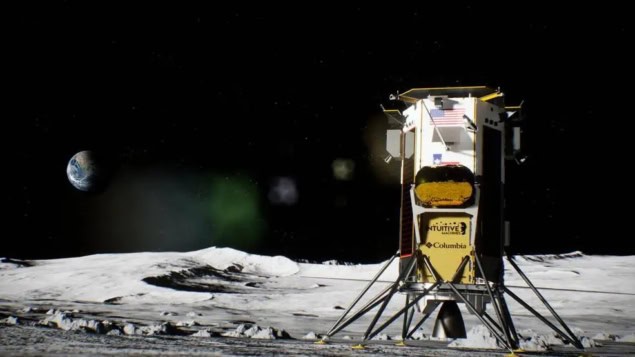
- Update 7 March 2025: In a statement, Intuitive Machines announced that while Athena performed a soft landing on the Moon on 6 March, it landed on its side about 250m away from the intended landing spot. Given that the lander is unable to recharge its batteries, the firm declared the mission over with the team accessing the data that has been collected.
The private firm Intuitive Machines has launched a lunar lander to test extraction methods for water and volatile gases. The six-legged Moon lander, dubbed Athena, took off yesterday aboard a SpaceX Falcon 9 rocket from NASA’s Kennedy Space Center in Florida . Also aboard the rocket was NASA’s Lunar Trailblazer – a lunar orbiter that will investigate water on the Moon and its geology.
In February 2024, Intuitive Machines’ Odysseus mission became the first US mission to make a soft landing on the Moon since Apollo 17 and the first private craft to do so. After a few hiccups during landing, the mission carried out measurements with an optical and radio telescope before it ended seven days later.
Athena is the second lunar lander by Intuitive Machines in its quest to build infrastructure on the Moon that would be required for long-term lunar exploration.
The mission, standing almost five meters tall, aims to land in the Mons Mouton region, which is about 160 km from the lunar south pole.
It will use a drill to bore one meter into the surface and test the extraction of substances – including volatiles such as carbon dioxide as well as water – that it will then analyse with a mass spectrometer.
Athena also contains a “hopper” dubbed Grace that can travel up to 25 kilometres on the lunar surface. Carrying about 10 kg of payloads, the rocket-propelled drone will aim to take images of the lunar surface and explore nearby craters.
As well as Grace, Athena carries two rovers. MAPP, built by Lunar Outpost, will autonomously navigate the lunar surface while a small, lightweight rover dubbed Yaoki, which has been built by the Japanese firm Dymon, will explore the Moon within 50 meters of the lander.
Athena is part of NASA’s $2.6bn Commercial Lunar Payload Services initiative, which contracts the private sector to develop missions with the aim of reducing costs.
Taking the Moon’s temperature
Lunar Trailblazer, meanwhile, will spend two years orbiting the Moon from a 100 km altitude polar orbit. Weighing 200 kg and about the size of a washing machine, it will map the distribution of water on the Moon’s surface about 12 times a day with a resolution of about 50 meters.
While it is known that water exists on the lunar surface, little is known about its form, abundance, distribution or how it arrived. Various hypothesis range from “wet” asteroids crashing into the Moon to volcanic eruptions producing water vapour from the Moon’s interior.

To help answer that question, the craft will examine water deposits via an imaging spectrometer dubbed the High-resolution Volatiles and Minerals Moon Mapper that has been built by NASA’s Jet Propulsion Laboratory.
A thermal mapper, meanwhile, that has been developed by the University of Oxford, will plot the temperature of the Moon’s surface and help to confirm the presence and location of water.
Lunar Trailblazer was selected in 2019 as part of NASA’s Small Innovative Missions for Planetary Exploration programme.



